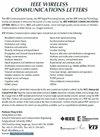Federated Learning-Aided Dual-Side Channel Estimation in Multi-User Massive MIMO Systems
IF 5.5
3区 计算机科学
Q1 COMPUTER SCIENCE, INFORMATION SYSTEMS
引用次数: 0
Abstract
In massive multiple-input multiple-output (MIMO) systems, attaining precise channel state information (CSI) tends to cause significant pilot overhead and prohibitive computational complexity. In light of this, data-driven approaches have been developed by training neural network models that recover channels from received signals. Since the conventional centralized learning (CL) would bring substantial communication overhead and privacy risks, federated learning (FL) has emerged as a promising alternative, allowing the base station (BS) to collect only model parameters from users, without the whole dataset. However, the previous work focus solely on either downlink or uplink channel estimation, neglecting the potential interplay between such two processes. In this letter, we design a consistent FL framework to estimate both the CSI at the receiver side (CSIR) and the CSI at the transmitter side (CSIT). Specifically, the beamformers at both end during preamble phases are delicately designed, which enables the parameters trained from the downlink models to be fully utilized for uplink channel estimation, thereby further reducing the communication overhead. Simulation results demonstrates that the proposed approach achieves better estimation performance compared to the existing analytical methods, and shows pleasurable robustness adapted to varying environments.联合学习辅助的多用户大规模MIMO系统双边信道估计
在大规模多输入多输出(MIMO)系统中,获得精确的信道状态信息(CSI)往往会导致显著的导频开销和令人望而却步的计算复杂性。鉴于此,数据驱动的方法已经通过训练神经网络模型来开发,这些模型可以从接收的信号中恢复通道。由于传统的集中式学习(CL)会带来大量的通信开销和隐私风险,联邦学习(FL)已经成为一种有前途的替代方案,它允许基站(BS)仅从用户那里收集模型参数,而无需收集整个数据集。然而,以前的工作只关注下行或上行信道估计,而忽略了这两个过程之间潜在的相互作用。在这封信中,我们设计了一个一致的FL框架来估计接收端(CSIR)和发送端(CSIT)的CSI。具体来说,在前端阶段对两端的波束形成器进行了精心设计,使下行模型训练的参数能够充分用于上行信道估计,从而进一步降低通信开销。仿真结果表明,与现有的分析方法相比,该方法具有更好的估计性能,并且具有良好的鲁棒性。
本文章由计算机程序翻译,如有差异,请以英文原文为准。
求助全文
约1分钟内获得全文
求助全文
来源期刊

IEEE Wireless Communications Letters
Engineering-Electrical and Electronic Engineering
CiteScore
12.30
自引率
6.30%
发文量
481
期刊介绍:
IEEE Wireless Communications Letters publishes short papers in a rapid publication cycle on advances in the state-of-the-art of wireless communications. Both theoretical contributions (including new techniques, concepts, and analyses) and practical contributions (including system experiments and prototypes, and new applications) are encouraged. This journal focuses on the physical layer and the link layer of wireless communication systems.
 求助内容:
求助内容: 应助结果提醒方式:
应助结果提醒方式:


